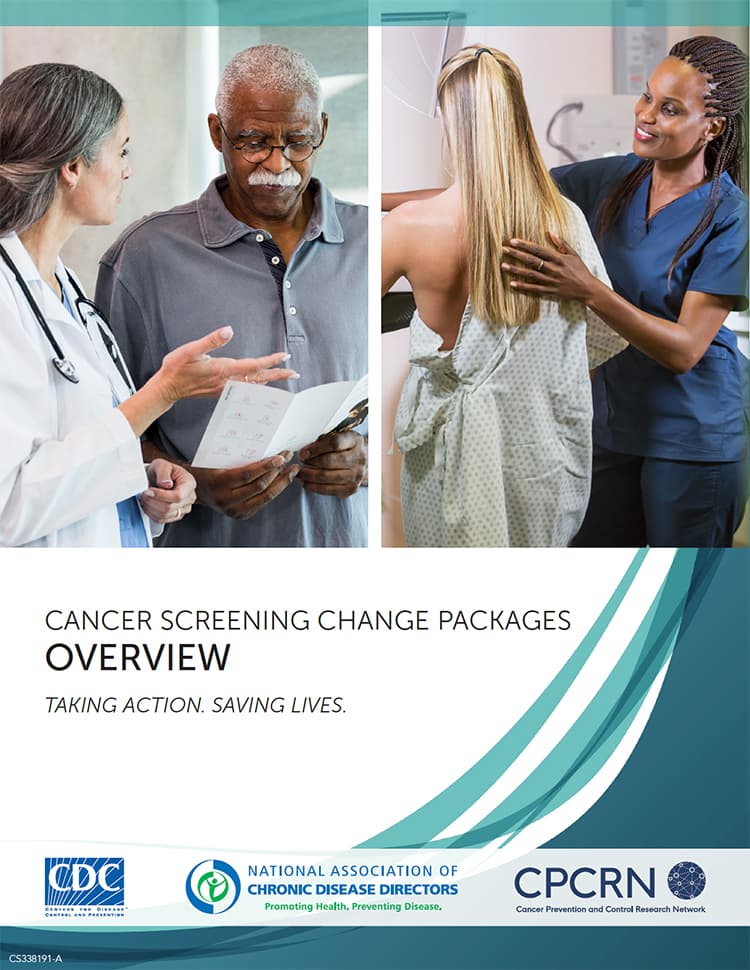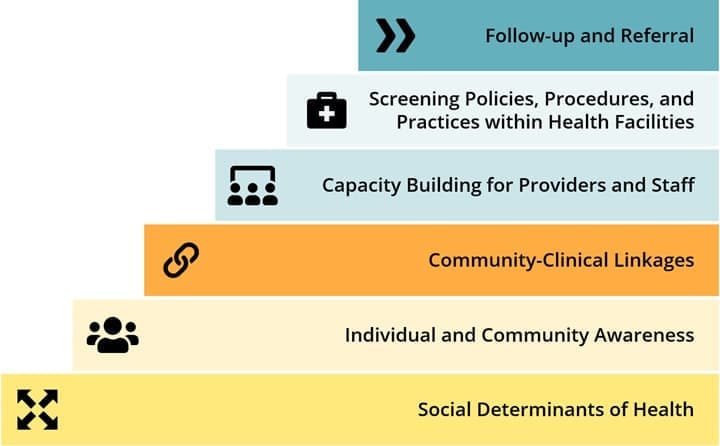Cancer Screening Change Packages
Taking Action. Saving Lives.
This video features Avid Reza, MD, MPH and Stephanie Melillo, MPH discussing the functions of the Cancer Screening Change Package.

Learn more [PDF-2MB] about the organizational framework for the cancer screening change packages and how to apply it with your own program.
The Cancer Screening Change Packages are intended to support the delivery of cancer screening services that have received A or B recommendations from the United States Preventive Services Task Force (USPSTF). These packages—
- Are intended for health care professionals in various clinical settings, including single and group practices, health maintenance organizations, Federally Qualified Health Centers, imaging and cancer center facilities, and public health departments, and the practitioners who partner with them.
- Present a list of evidence-based and practice-based changes that clinicians can select from to improve cancer screening.
- Provide clinical teams with practical tools and resources that can be used or adapted to improve the reach and effectiveness of their cancer screening efforts.
- Take into consideration that the decision to start the screening process may begin before a person engages with the health care system (see Appendix A in the Overview PDF). Therefore, these change packages provide tools and resources to address information gaps and barriers to recommended cancer screening.
For more information, please see Frequently Asked Questions.
Access the Cancer Screening Change Packages
The Cancer Screening Change Packages are available for breast, cervical, and colorectal cancers. Phase 2 will add a change package for lung cancer.
Click an image below to select a change package.
Organizing framework of the Cancer Screening Change Packages
Cancer screening services may be improved by implementing change concepts,1 change ideas,1 and relevant tools and resources.
- Change concepts are “general notions that are useful for developing more specific strategies for changing a process.”
- Change ideas are “actionable, specific ideas or strategies”1 for changing a process. These change packages include evidence-based and practice-based change ideas.
- Each change idea is linked to tools and resources that can be used or adapted to improve cancer screening.
The following six focus areas organize the change concepts, change ideas, and tools and resources in these Cancer Screening Change Packages—

See the Cancer Screening Change Packages: Overview [PDF-792KB] for definitions of the focus areas and the list of change concepts and change ideas for each area.
How to use the Cancer Screening Change Packages
The Cancer Screening Change Packages offer a menu of strategies and associated tools and resources to support cancer screening services. Health care professionals—and the public health departments, community-based organizations, and others who partner or collaborate with them—can choose tools and resources from this menu to address processes that need improvement. Some may approach these change packages with a specific goal in mind. Others may need to identify the areas for improvement. The steps below explain how to use the Cancer Screening Change Packages.
To get started—
- Engage team members and potential partners. These may include physicians, pharmacists, nurses, medical assistants, social workers, community health workers, patient navigators, quality improvement coordinators, health informaticians, administrators, health department staff, and members of community-based organizations.
- Establish leadership support and commitment to improving cancer screening.
- Identify one or more champions to engage leadership and lead efforts.
Working with the change package
- Become familiar with the organizing framework: focus areas, change concepts, and change ideas.
- Review the flow charts in Appendix A of the Cancer Screening Change Packages: Overview [PDF-792KB] to understand the cancer screening process that patients follow and the opportunities to improve screening.
- Determine if a needs assessment would help identify focus areas, change concepts, and change ideas that would be most effective and feasible.
- Select a focus area based on circumstances and needs.
- Identify appropriate evidence-based and practice-based change concepts and change ideas.
- Select tools and resources for implementation and adapt as necessary.
- Implement, monitor, and evaluate the selected changes and associated tools and resources.
Frequently Asked Questions
Send feedback
The Cancer Screening Change Packages may be updated periodically as screening processes evolve and tools and resources are developed and disseminated. Although the project team used a systematic search, some tools and resources may have been missed. Please send comments, questions, and suggestions to dcpccommunications@cdc.gov.
Disclaimer
CDC has identified resources that may be beneficial to support the delivery of cancer screening. However, CDC does not endorse any specific resource nor is the list of resources provided an exhaustive list of all resources that may be available.
Reference
1Centers for Disease Control and Prevention. Tobacco Cessation Change Package. Atlanta, GA: Centers for Disease Control and Prevention, U.S. Department of Health and Human Services; 2019.